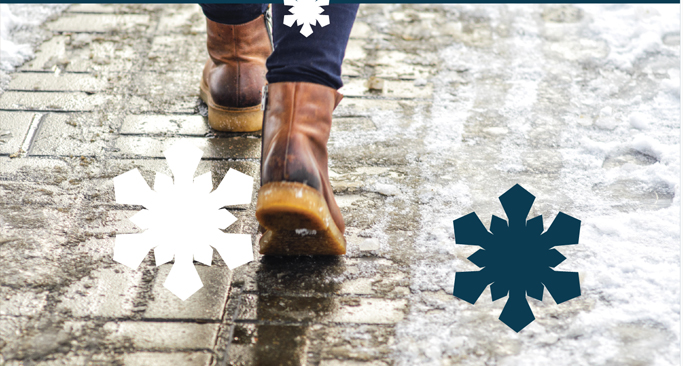Recommendations to share with
clients to lower their risk profile
By Eric Spacek
Winter is fraught with risk for your customers. From slips and falls on ice, to vehicle troubles, to the threat of carbon monoxide poisoning, there are myriad reasons why customers may need to submit claims. Many of these potential challenges are preventable.
The foundation of the insurance industry is risk management, and the best insurance professionals offer easily digestible tips for their customers to help them prevent winter-related injuries and deaths. The following are a few of the most important guidelines that organizations should follow to protect their people and their facility when the temperatures get low. You can share these recommendations with customers to help them lower their risk profile.
Avoid slipping in a winter wonderland
Even in warmer climates, ice can accumulate and become hazardous. And in areas where temperatures approach or drop below freezing, your outside walkways and parking lot can quickly become treacherous. As an organization, you should:
- Establish a process for clearing ice and snow. Whether you hire an outside contractor or not, you should have a point person in your organization who is responsible for making sure your sidewalks and parking lot are cleared. When there is snowfall during hours people are on site, those workers should be clearing snow at regular intervals and using salt or sand to melt ice.
- Keep bags of salt or sand readily available just inside your doors. Sometimes, it can be difficult to predict icy conditions. Make it easy for staff and volunteers to find de-icing supplies quickly.
- Prevent ice from accumulating on the outside of your building. This can happen when clogged roof gutters cause melted ice and snow to drip down from the roof, forming icicles or dangerous spots on your walkway. Remember to keep gutters and downspouts clear in advance of winter and have a plan to address excessive snow build-up and ice dams at your facility.
- Shovel or plow before salting or sanding. You need to remove all the snow and loose ice so the salt or sand can work its de-icing magic.
Keep people upright in your halls and doorways
It would be a cruel irony if employees, volunteers, or guests traversed a snowstorm outside, only to slip and fall as soon as they walked in your doors. Winter requires extra diligence in keeping the inside of your building hazard free. To do so, you should:
- Assign a staff member to keep a close eye on your doorways in inclement weather. When it’s snowing outside, everyone who enters your doors will be tracking moisture inside. The staff member should be checking and cleaning the floor on a regular basis. Post “wet floor” signs in the area to warn people of potentially slippery conditions.
- Place walk-off mats in every entrance. This will help trap rain, snow, dirt, and anything else being tracked in from outside that may lead to a slip and fall.
- Keep all indoor steps clear of debris and obstacles. You should also ensure that steps and landings are well lit, and check that steps are appropriately constructed and have sturdy handrails.
- Make it easy for people to report hazards and near misses. Not only is it important to document and rectify actual falls, but people in your building should also call attention to near misses. Develop a culture in your organization that encourages people to tell someone when they notice a dangerous practice or temporary hazard, such as water in the doorway.
Protect your people when they’re on the road
There’s no doubt about it—winter driving can be treacherous. Not only are roads more slippery and unpredictable, but colder temperatures can also cause vehicle problems that can leave drivers and their passengers stranded with no way to warm themselves.
It’s imperative you take steps to help anyone who is driving a vehicle for your organization.
It would be a cruel irony if
employees, volunteers, or
guests traversed a snowstorm
outside, only to slip and fall
as soon as they walked in your doors.
Those steps include:
- Provide snow tires when necessary. If you live in an area that experiences extremely cold temperatures and heavy snow, you may consider changing to snow tires for the winter. Such tires are designed to provide increased traction at low temperatures and are built with tread patterns that grip better on snow and ice.
Remind drivers to keep an eye on their gas tank. Gas tanks should always be at least half full to avoid the risk of frozen fuel lines, condensation buildup, and running out of gas in adverse weather.
- Keep a first-aid kit and necessary winter supplies in each of your vehicles. Those supplies include extra warm clothes, a blanket, flares, jumper cables and a charging cable that can be used for various kinds of cellphones.

- Use the right engine oil. Oil thickens as the temperature drops, which makes it harder for the engine to run smoothly. Check your owner’s manual to learn which oil you should use in cold weather.
- Change windshield wiper fluid and check it on a regular basis. In extremely cold temperatures, wiper fluid can freeze, which creates a hazard for drivers. You can avoid such a situation by changing the fluid to a type that withstands colder temperatures.
- Test the batteries on all your vehicles. Batteries are more likely to fail in the winter, which could leave one of your drivers and their passengers stranded. Make sure all batteries are functioning at full capacity.
- Check the rear-window defroster. Because that feature isn’t used very often in the summer, it can fall into disrepair. If a driver can’t see out of the rear window, that can create a major hazard. If you haven’t already done so this season, make sure to check the rear-window defroster for all the vehicles in your fleet.
Guard against carbon monoxide (CO) poisoning
Portable generators and heaters can create dangerous levels of CO when they are used in enclosed buildings. The best way for organizations to lower their risk is to have all furnaces, gas stoves and fireplaces checked annually by a qualified professional.
Other important preventive measures include:
- Install CO alarms. Organizations should install CO alarms throughout their facility, test them regularly, and replace them every five to seven years.
- Never use generators indoors. If there is a power outage, generators should always be placed at least 10 to 15 feet away from the facility.
- Use kitchen vents whenever the stove is running. CO poisoning cases can result from a kitchen stove. Organizations should run the exhaust fan when cooking and open a nearby window to allow fresh air to circulate.
- Clean out fireplace flues. It’s important to establish a routine of cleaning out the flue before every use to prevent it from becoming clogged. A clogged flue can trap CO in a building.
- Never idle vehicles in a garage or outside for long. This could bring CO into the building’s air input system, putting everyone in the building in danger.
- Never use gas-powered tools indoors or in confined spaces. This could result in the space becoming permeated with CO, putting the user in extreme danger.
It’s also important for organizations to train their employees, volunteers, and members about the signs of CO poisoning. They include:
- Headache
- Dizziness
- Nausea
- Flu-like symptoms
- Tightness across the chest
- Shortness of breath
- Drowsiness
- Fatigue
Throughout the winter, insurance companies field many claim reports that could have been avoided if the customer had taken proper precautions. Information is power, so arm your customers with that power.
The author
Erik Spacek is assistant vice president–risk control at Church Mutual Insurance Company, S.I. He earned a bachelor’s degree in English from Eastern University in St. David’s, Pennsylvania, and his juris doctor degree from American University in Washington, D.C. He earned the Associate in Risk Management (ARM) designation and has received the Cambridge Certificate in Risk Management for Churches and Schools. Spacek serves on the board of directors of the Iowa Prayer Breakfast Committee and on the board of directors of the Friends of Youth Justice Initiative in West Des Moines, Iowa.






